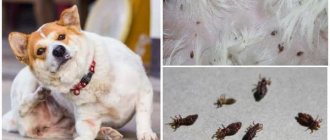What do fleas look like on dogs and how do they reproduce?
Dog fleas are small - their body length is about 2-4 mm. The chitinous cover, consisting of many bristles, allows the parasite to firmly adhere to the fur and move quickly. Fleas jump well - 3 times further than they can see.
This canine parasite is hardy, so it tolerates sudden temperature changes, high humidity, and even develops resistance to chemicals.
The flea's mouthparts are adapted to the dog's skin, but if there is a lack of food, the parasite can bite a person or other animal. If there is not enough food, the insect hibernates.
The flea has a complex reproductive system. Mating can last up to 10 hours. Almost all parasites begin copulation after drinking blood. After fertilization, the female immediately lays eggs. A flea can lay up to 10 eggs at a time.
Reproduction occurs in favorable conditions: in rags, dust, woolen products, a booth, on the floor, in clothes. The eggs are oblong in shape and resemble grains of rice.
Dangerous neighborhood
When parasites are found on a pet's fur, a logical question arises: can fleas spread from a dog to a person? The interest is due to the fact that people, as a rule, have very close contact with their four-legged pets, which increases the risk of infection with parasites that they carry on their bodies.
Sign of fleas in a dog
If, after returning from a walk, your beloved pet begins to itch intensely, there is a possibility that he has parasitic insects that can be transmitted to humans. Their main food is blood, and they live in wool and lay eggs in it.
Note! A flea can easily be confused with an ordinary particle of dirt. If such a particle begins to actively jump, then there is no doubt – it is a parasitic insect.
If a person decides to pet a stray dog from the street, it is unlikely that the insects will move to him, which cannot be said about a large number of germs, so after contact it is necessary to wash your hands thoroughly. But there is still a small possibility. By petting a stray dog, you can bring the bloodsucker into the house. This presence will cause great discomfort. In addition, parasites can carry dangerous infections, so getting rid of insects is imperative.
Note! Dog fleas are dangerous for humans - and this is a proven fact. Scratching bites can cause secondary infection.
What does a flea look like?
Reasons for appearance
The flea invasion occurs in the warm season and begins in spring and ends in October. Parasites choose their refuge in private houses or on the first floor of apartment buildings.
Fleas can be caused by contact with other dogs.
The main sources are:
- dirty entrances;
- neighboring apartments;
- infected pets;
- flea colonies in the basement or attic;
- presence of rats and mice;
- garbage dumps.
Fleas lay eggs in an animal's fur, so the owner can transmit parasites to his pet if he first pets an infected dog and then a healthy one.
About methods of struggle
Given the urgency of the problem, veterinary pharmacies and specialized pet stores have a wide range of products for dog fleas. These include:
- Sprays. More suitable for an adult pet if the latter is completely healthy. The difficulty is in spraying the chemical, which can get into your pet's eyes or mouth. The advantage is instant results.
- Drops on the withers. One of the most reliable and common methods.
- Shampoos. Available for removing fleas from puppies if you follow the instructions.
- Collars. They are better known for their preventive properties. They repel insects.
- Powder. It is rubbed into the pet’s fur and washed off after a while.
- Tablets and injections. They are used less frequently than others and only as prescribed by a doctor.
- . If your pet is sick, as well as in the case of pregnant dogs, you can use decoctions of fragrant herbs - lavender, tansy, wormwood.
It is worth remembering that after treating an animal with special flea products, you should also replace or treat its bedding, as well as the entire room, especially if the animal is heavily infested.
Dog fleas are not a very common species. They are often confused with cats and vice versa. They can bite both their immediate “owner” and have a snack by jumping on a person. A variety of insecticides will help get rid of them, which are chosen according to the age, sometimes breed and health status of the dog.
Can they transfer to people?
Fleas cannot live on humans, so they are not transmitted to people from sick animals. However, if your pet brings this insect back from a walk, immediate action should be taken. If there are too many fleas, they may bite people in search of food.
Fleas live on bedding or carpets, in garbage. If, for example, an animal left the house for some time, and parasites remained on its blanket, then they will begin to attack people in order to satisfy their hunger.
How they bite
The oral apparatus is designed in such a way that it is convenient to suck blood . Fleas' sense of smell allows them to identify humans by the smell of carbon dioxide. Once on the body, the insect bites through the skin and begins to suck blood. The parasite's proboscis is short, so it inserts both its head and part of its body into the wound, assuming a vertical position.
The flea does not mask the bite with an anesthetic, so it causes pain to the victim. During the puncture process, the insect injects saliva, which impairs blood clotting, and along with it harmful bacteria.
Having received a portion of blood from one wound, the parasite crawls a few centimeters and makes a new one. During one feeding, the insect makes 3-5 bites.
Flea bites.
Consequences of bites
The consequences of a bite can be:
- various skin lesions, ranging from severe itching to abscesses and dermatitis;
- high fever;
- development of brucellosis;
- transfer of worms, tapeworms from the previous “owner”;
- sleep disturbance.
When scratching the bite area, boils, abscesses and growths can form.
An allergic reaction is a common consequence.
What consequences can dog flea bites cause?
If a dog has any parasites, the risk of their carriers being transferred through fleas to the human body increases. You don’t have to have pets to bring fleas into your home—prolonged physical contact with a stray dog can have the most negative consequences.
The degree of danger of dog fleas to humans depends on many factors, so possible harm can be expressed in the following:
- the occurrence of an allergy in a person to the saliva of a bloodsucker - itching, dermatitis appears, chronic skin diseases worsen, body temperature rises, respiratory and intestinal disorders worsen;
- brucellosis develops, which can lead to damage to internal organs;
- from the previous “carrier” a person can get endoparasites – worms, tapeworms, and other types of parasites;
- A flea bite can cause many dangerous diseases: encephalitis, ulcers, typhus, plague. This happens extremely rarely.
How to fight
If parasites are found, disinsection must be carried out. To treat the room you will need a soda or saline solution (you can also add insecticidal shampoo).
The algorithm of actions is as follows:
- Thoroughly vacuum the entire apartment, including upholstered furniture.
- Send for cleaning things that could harbor pests.
- Throw out the animal's bedding (it is recommended to change it more often), and treat all items belonging to the dog.
- Carry out wet cleaning with a solution.
- Close doors and windows hermetically.
- Move furniture away from the wall, treat all cracks, corners, carpets and other surfaces with insecticide.
- Leave the apartment for a few hours.
- Upon return, ventilate well.
- Do the cleaning again.
An option for flea control is a collar.
This treatment must be repeated after a week to ensure that both larvae and eggs are destroyed.
In a private house, it is necessary to treat not only the interior, but also the basement, cellar, attic and all outbuildings and the surrounding area.
Dog house treatment
The booth is disinfected after it is cleaned. To avoid “flooding”, you first need to dig drainage ditches at an angle. The entire house needs to be treated, both inside and outside.
The procedure can be carried out using an aqueous solution of formalin, creolin or Lysol. Creolin is used more often because it is easier to buy and easier to dilute with water.
Regular scheduled treatments are carried out in winter, spring and autumn. In summer, disinfection is carried out every month. The kennel is washed out unscheduled with a solution if a flea infestation has been detected, or before moving a new pet into it.
Whatever solution is used for treatment, the animal should not be allowed near the booth until it is completely dry. Otherwise, there is a risk of harming your pet's health.
Animal handling
It is possible to remove these parasites yourself at home if a severe infection has not yet occurred.
The fastest way to get rid of parasites is to use a spray. After treatment, the drug begins to act instantly, the protective effect lasts about a month. Before spraying, you need to straighten the animal's fur so that the liquid gets on the skin. Everything is treated except the head. The pet needs to be occupied with playing for a while so that the drug has time to dry.
Drops are considered a more effective remedy, but they begin to act only on the 2nd day. During this period, the animal should not be bathed so as not to wash off the medicine. The drug is applied directly to the skin from the back of the head to the withers.
A special flea collar is the safest remedy. A plastic headband with insect repellent is more suitable for prevention. You need to wear it constantly, it begins to act gradually. The duration of the collar is indicated on the packaging.
Are there any differences from cats?
Many people are interested in whether cat fleas and dog fleas are the same or different? Each of these species has its own characteristic features, both external and behavioral.
The dog pest is a wingless ectoparasite, reaching a length of up to 5 mm, while the cat pest is smaller. This is a tenacious and temperature-resistant insect, capable of jumping up to 50 cm in length.
Like cats, the canine parasite has a shape flattened along the lateral segments and a sucking-piercing oral apparatus of a functional type.
The main difference between dog fleas and cat fleas is that for unhindered movement or jumping, dog insects have characteristic 8 bristles (cat fleas have 6) plus spines.
The head, unlike cats, is more rounded, the head plus thoracic sections are distinguished by the presence of jagged ridges, as well as ctenidia, which help cling to fur or clothing.
The limbs are powerful and well developed, which allows them to move freely on any surface. The color of the shell varies from glossy brown to black. The differences between dog fleas and cat fleas are clearly visible when examined under a microscope.
Prevention of animal infection
You can prevent blood-sucking insects from appearing on your dog if you regularly examine it after walks. Since fleas can even travel on human clothes and shoes, at the slightest suspicion of their presence, the pet should be bathed with an insecticidal shampoo.
These insects are active all year round, so animals constantly need effective protection. This is especially true for those dogs whose owners transport them to the countryside for the summer. You can protect animals from fleas and ticks using the same collars, drops and sprays that are used to get rid of insects and arachnids.











